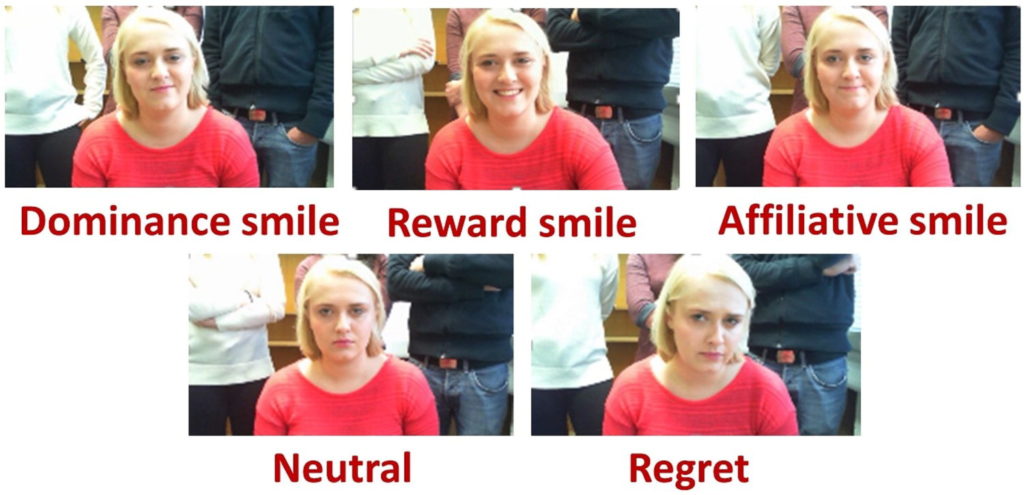A smile is a common feature of many teachers’ faces. Whether to keep a positive atmosphere in the classroom or to encourage a frustrated student, smiling can be used to help keep the class in a positive mood and ready to learn. Because they are so often used, however, smiling can sometimes become a bit stale and students may question the genuine nature of the smiles when they aren’t felt to be genuine or are otherwise misused.
A smile isn’t just a smile, however, as there are several types of smiles that can be used in different situations to different effects. Research has just come out detailing three types of smiles and how they can affect the trust between people.
New Research on Types of Smiles

Research conducted at Queen’s University, Belfast pitted participants against a seemingly unfair opponent in a game to see how various types of facial expressions would affect participants feelings towards the unfair player. The types of facial expressions used were; Dominance smile, Reward Smile, Affiliative Smile, a regretful expression and a neutral facial expression as control.
A dominance smile is a smirk where the smiler seems to be taking joy in being superior or hurting others. It is one often employed in movies by the villain and shows that not all smiles can be assumed to be positive in nature. The reward smile is a fuller smile with bright eyes and often showing teeth. It is used to show that the smiler is pleased with the person they are smiling at and what they have done. The third smile, the affiliative smile, is a more subtle smile that is used to try to elicit or show understanding and create a connection between parties.
The participants in the research study were set to play an economics game where one can work with their opponents or against them for more personal gain. At a certain point in the game, the opponent seems to make an uncooperative or unfair move and then gives the participant one of the aforementioned expressions.
“We found that when a person smiled after being uncooperative or untrustworthy, they were viewed as being happy and therefore they appeared untrustworthy and unwilling to change their behavior. However, when an affiliation smile was used, this was perceived as an attempt to make amends, restoring higher levels of trust than the other two smiles.” (Rychlowska et al.)
This interesting finding shows that it isn’t just whether or not a person smiles, but the types of smiles that can create or destroy a bond between people. When one participant is happy and the other upset, this creates a discordance in their experiences which drives the two parties apart, but when the supposed “unfair” player smiled in a way that seemed to suggest they feel bad or are trying to make amends, this led more people to forgive the supposed slight.
Teacher Takeaway
While no teacher would purposefully be unfair to their students, it isn’t an uncommon occurrence for a student to feel that a teacher is being unfair in their minds. If a student complains that a test question was unfair, a teacher could respond in several ways. If the teacher responds with something they perceive as “fun” like saying “I knew that would be a tricky one! You’ll have to read more carefully next time” especially if that is combined with a dominating smile, this could make the student feel like the teacher is an adversary rather than someone there to help them learn.
While some relationships flourish with a bit of light teasing and challenging back-and-forth, this approach should only be used when there is already solid rapport with the student and the teacher knows it won’t discourage them.
However, the opposite approach won’t do much better. If the teacher, instead of a dominating smile, gives a big happy “reward” smile and says something like “Don’t worry about it, you did great!” it may cause the student to feel the teacher is just pandering to their feelings and isn’t being honest.
Not only does this response not directly answer the implicit question about the unfair nature of the question, the big grin and focus on the positive while they are focused on the negative will make the student feel that the teacher isn’t understanding them or has given up on them actually doing a good job. A big smile can be great when everyone is sharing in the same joy, it feels fake and dismissive when both teacher and student aren’t on the same page.

Instead, teachers should try the affiliative smile and validate what the student is feeling. Saying something like “Awe, I’m sorry that question was tough! Do you want to talk it through? Maybe I was too tough.” will make the student feel understood and show that the teacher is understanding where they are coming from.
Even if discussion isn’t possible at the moment, the teacher planning a window of time after class or at another free point where they can discuss the grievance with the student will feel understood, and if they truly feel slighted, the teacher can help mend the feelings during the discussion.
Context truly matters when talking about types of smiles. While a dominating smile may create a competitive feeling in the student and make the teacher seem like an opponent, this may in some cases actually be beneficial! During a competitive game where students work together to outwit or beat a goal set by the teacher, giving the students a dominating smile and challenging their ability to complete the challenge may boost their competitive nature and make them redouble their efforts.
The important thing to keep in mind is the context, which in this case is a game where everyone is having fun and engaged. The dominating smile in this case is going to be understood as just part of the game and can be blended with more affiliative or understanding smiles for shy or non competitive students to help them not feel overwhelmed.
What is most important is understanding the context and personality of each student. As long as teacher and student are emotionally matched, the smiles are more likely to be successful. No amount of research can supersede a teacher’s ability to know their students personally and know what works with them, but this research will hopefully make teachers more mindful of the facial expressions they choose and the manner in which they interact with their students to stay on the same page emotionally and create an environment of understanding. While the types of smiles a teacher might use may seem like an insignificant detail, sometimes a smile is worth a thousand words to a student in need.
Want more like this? Make Lab to Class a part of your weekly professional development schedule by subscribing to updates below.
References
Rychlowska, Magdalena et al. “Dominance, Reward, And Affiliation Smiles Modulate The Meaning Of Uncooperative Or Untrustworthy Behaviour”. Cognition And Emotion, 2021, pp. 1-21. Informa UK Limited, doi:10.1080/02699931.2021.1948391. Accessed 9 Sept 2021.



